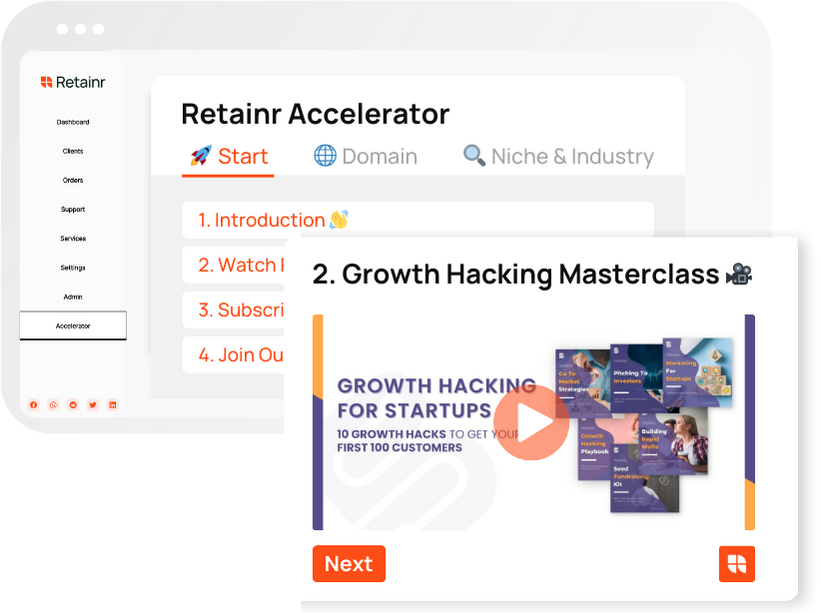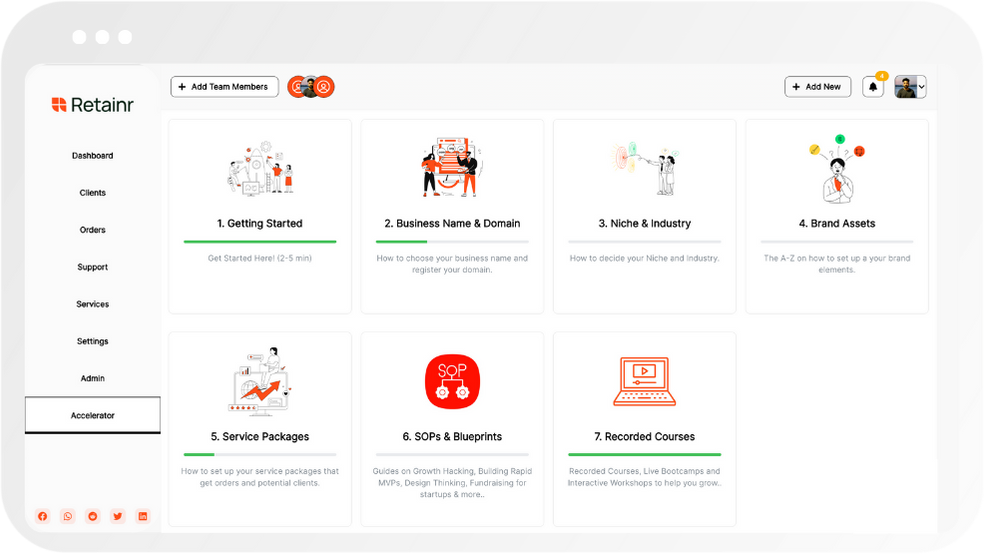
How to Choose Workflow Automation Tools and Software
Build with Retainr
Sell your products and services, manage clients, orders, payments, automate your client onboarding and management with your own branded web application.
Get Started1. What factors should I consider when choosing workflow automation tools and software?
Understanding Your Business Requirements and Workflow Needs
Before you choose a workflow automation tool, it's crucial to identify your business objectives and workflow requirements. Think about the specific tasks that need automation. Are they simple or complex, frequent or occasional? Recognize your workflow key features, such as parallel or serial approvals, forms, task delegation, dashboards, reports, and secure access.
- Complex workflows: If your workflows involve complex processes with multiple steps and stakeholders, you may need a feature-rich tool. This may include advanced functionalities like parallel approvals, multi-level hierarchies, and data-driven automation triggers.
- Simple workflows: For smaller teams or simpler processes, a basic tool with features like task tracking, due date reminders, and easy-to-use UI might be enough.
Considering The Vendor’s Reputation and Customer Support
It's important to research the reputation of the vendor offering the workflow automation software. Look for customer testimonials, case studies, and user reviews to understand the experiences of other customers with the tool. Consider the quality of customer support offered. Is it readily available, knowledgeable, and friendly?
| Vendor's Reputation | Customer Support |
|---|---|
| Check vendor's credibility in the market | Should have 24/7 support |
| Look for customer testimonials and case studies | Must offer multiple channels for contact |
| Research about user's true experience with the software through reviews | Check if the support team is knowledgeable, friendly and can solve queries promptly |
Evaluating System Flexibility, Scalability, and Integration
Choose a workflow automation tool that is flexible and can easily adapt to your evolving business processes. It should integrate seamlessly with your existing systems and software, and it must be scalable to accommodate business growth or changing needs. Lastly, ensure that the tool is user-friendly, convenient, and does not require extensive training or technical skills to operate.
- Integration: The tool should work well with your existing applications, databases, and software.
- Scalability: The tool must be able to grow and change as the size, complexity, and needs of your business evolve.
- User-Friendly: The tool should be easy to use and manage, requiring minimal training and technical skills.
2. How can the right workflow automation tool benefit my business process?
The Benefits of Choosing the Right Workflow Automation Tool
When chosen wisely, the right workflow automation tool can have multiple advantages for your business process. A well-designed system will increase efficiency, improve accuracy, and allow for better tracking of key processes. It means less time spent managing tasks manually and more time free for strategic thinking, decision making, and greater attention to critical areas of your company.
- Increased Efficiency: Automated tools streamline business processes by eliminating manual tasks and reducing the time spent on paperwork and administrative work. For example, eSignature software can automate the agreement process from start to finish while reducing errors and increasing speed.
- Improved Accuracy: Manual tasks are prone to errors which can be costly to your business. Automating data and task management reduces the risk of this, especially in areas like invoicing, data entry, and reporting.
- Better Tracking: Workflow automation tools also come equipped with tracking features that allow for real-time visibility into your processes. You can monitor task progress, see who is responsible for what, and ensure overall accountability within your team.
Consider choosing workflow automation software based on the specific needs of your unique business. The following table lists important criteria that should weigh into your decision.
| Criteria | Description |
|---|---|
| Scalability | A tool that can grow with your business, accommodating increasing workloads or additional employee users as needed. |
| Functionality | The software should include all necessary features for your business processes (document management, task assignment, tracking, etc.). |
| Integration Capabilities | The tool should be able to integrate smoothly with your current digital environment (CRM, ERP, email, etc.) to ensure seamless data transfer. |
| User-Friendly Interface | The tool should be intuitive and easy to usage. This will facilitate adoption by your team and thus ensure successfull implementation. |
3. Are there specific features I should look out for in a workflow automation software?
Consideration of Necessary Features
When selecting workflow automation tools and software, several highly valuable features may help streamline your operational processes. Firstly, the tool should have customizable, Form Design Capabilities which allow for the creation of custom fields, sections, and visual elements aligned with your business identity.
- Integration Ease
- Automated Alert and Notification Features
- Comprehensive Dashboards and Reporting Tools
- Seamless Process Mapping
Understanding Advanced Features
In addition to baseline features, advanced features can add significant value to your workflow automation. Such functionalities include a Supportive Mobile Platform which allows for task handling and process management on-the-go. Moreover, Conditional Logic lets you set tasks and follow-up actions based on the outcomes of preceding tasks, providing dynamic, intuitive workflow control.
| Advance Feature | Description |
|---|---|
| Data Analysis and AI capabilities | Helps in detecting trends and making future predictions. |
| Compliance and security tools | Ensures data protection and adherence to regulations. |
Assessing User Friendliness
A good workflow automation software should also be user-friendly, meaning it is easy to learn and intuitive to use. Key factors to consider include:
- Setup and integration ease
- Intuitive UI/UX
- Quality and accessibility of customer support
- Detailed documentation and user guides
4. Which are some of the top-rated workflow automation tools in the market?
Top-Rated Workflow Automation Tools
There are various workflow automation tools available in the market. Selecting the right tool depends on several factors including your business needs, team size, budget, and ease of use. Some of the top-rated workflow automation tools currently making their mark in the market include:
- Zapier: Known for its ease of use and extensive application integration capability. It allows users to create workflows in minutes without any technical knowledge.
- nTask: This tool is suitable for managing and automating complex tasks. It offers several features like task assignment, risk management, and meeting scheduling.
- Integromat: This tool provides a visual interface for creating workflows. It supports multiple application integrations and easy debugging of workflows.
- Process Street: Popular for its user-friendly interface, this tool provides businesses with a straightforward way to manage recurring workflows.
Features and Pricing of Top Workflow Automation Tools
To further clear the picture and provide a better understanding, here is a brief overview of the features and pricing of these tools:
| Tool | Key Features | Pricing |
|---|---|---|
| Zapier | App integration, Workflow creation, Tasks automation | Free trial, Paid plans start at $20/monthly |
| nTask | Risk management, Tasks assignments, Meeting scheduling | Free version available, Pro plan at $3/user/monthly |
| Integromat | Multi-app integration, Easy debugging, Visual interface for workflows | Free version available, Basic Plan at $9/monthly |
| Process Street | Recurring workflows, User-friendly interface, Process documentation | Free trial, Paid plans start at $15/user/monthly |
Choosing the Right Tool for Your Business
In order to choose the right tool for your business, it's essential to clearly understand what your workflow automation needs are. There are certain factors that you can consider before making a decision:
- Integration: The tool should be able to integrate effectively with other applications that your business is using.
- Scalability: As your business grows, the tool should be able to scale accordingly to support larger workflows and more users.
- Usability: The tool should be user-friendly, making it easier for everyone in the team to use without needing technical expertise.
- Customer Support: A good support system ensures that any issues you encounter can be resolved promptly.
5. How do I determine the scalability of a workflow automation tool?
Determining The Scalability On A Workflow Automation Tool
Scalability is a crucial factor to consider when choosing a workflow automation tool or software. This signifies how well the chosen tool can adapt to an increase in workload without compromising in its efficiency or effectiveness. Here are some important factors to consider:
- Check product documentation or specifications. The user guide or product specs often provide information on the maximum load a product can handle.
- Look for scalability features. Tools that can scale usually have cloud-based flexibility, load balancing abilities, and the ability to add or subtract features or users as needed.
- Contact their customer support. Good providers will be upfront about their product's scalability and able to explain it in terms you understand.
A succinct way to observe these factors would be to organize them into a table:
| Scalability Factor | What To Look For |
|---|---|
| Product Documentation | Maximum load the product can handle |
| Scalability Features | Cloud-based flexibility, load balancing, ability to add/subtract features or users |
| Customer Support | Transparency and ease of explanation about the product's scalability |
Additionally, if it's possible, try to make use of the product's trial period to assess its suitability to your business needs as far as scalability is concerned. This evaluation method is direct and will likely provide you with the most accurate and reliable assessment of how it can support your operations when you scale up.
6. What does it mean for a workflow automation tool to be user-friendly and why is it important?
Understanding User-Friendly Workflow Automation Tools
A user-friendly workflow automation tool is one that is designed with the end user in mind, making it simple for individuals to navigate through the software without the need for specialized training. The main factors determining its user-friendliness include intelligible interface design, easy navigation, intuitive operation, rapid learning, and assistance availability. These features make the task of automating your workflows approachable and achievable for all members of your team, regardless of their technical abilities.
The relevance of user-friendly characteristics in workflow automation tools is demonstrated in the following points:
- Lessons the learning curve: A user-friendly tool reduces the amount of time and effort required to learn and familiarize with the software.
- Increase efficiency: It helps staff to accomplish tasks quicker and more efficiently, as they can navigate the system with ease.
- Encourages system use: If a system is easy to use, employees are more likely to use it, ensuring effective workflow automation.
- Reduces errors: Simple, intuitive interfaces can help to minimize mistakes, enhancing the accuracy of your processes.
Importance of User-Friendly Workflow Automation Tools
The importance of user-friendliness in workflow automation tools cannot be underestimated due to its impact on adoption and overall productivity. Choosing a user-friendly tool can drive the success of your workflow automation efforts. A summary of its benefits is presented below:
| Benefits | Details |
|---|---|
| Higher adoption rates | An easy-to-use tool encourages wider usage across the organization, eventually leading to increased adoption rates. |
| Maximized productivity | As learning processes are shortened and everyday tasks streamlined, staff can focus on more important aspects, thereby maximizing productivity. |
| Reduced costs | Training costs are significantly reduced when a software is straightforward and intuitive, thereby reducing overall tool implementation costs. |
7. How do I evaluate the integration capabilities of workflow automation software?
Evaluating the Integration Capabilities
The integration capabilities of a workflow automation tool should allow for seamless connection with other software and applications that your business uses. Here is how you can evaluate these capabilities:
- Number of integrations: Start by checking the number of third-party applications that the software can integrate with. More is generally better, but the quality of these integrations should also be important.
- Relevant integrations: Not all the integrations would be applicable to your particular scenario. Identify the software and applications you use daily and check if the tool integrates with them.
- Type of Integration: Some tools might integrate on a surface level, while others would have deep integration that allows exchange of complex data. Depending on your requirements, either could be suitable.
Checking for API Access
Another important feature is API (Application Programming Interface) access. API allows two software to communicate and share data. A good workflow automation tool should have the capability to talk to other software on a fundamental level using their APIs. The best way to evaluate this is:
| Ask | Clarification |
|---|---|
| Does the tool have an open API? | A 'yes' to this question means the tool can communicate with other software at a deep level. |
| What are the API limitations, if any? | Some tools may put a cap on the number of API calls to prevent excessive usage. Find out if such limitations would hinder your operations. |
| Is there support/documentation for the API? | Even the best of APIs will be of little use if they are hard to work with. Look out for an exhaustive tutorial or support available for implementing the API. |
8. What is the role of customer support in workflow automation tools and software?
Understanding the Role of Customer Support
Customer support plays a crucial role in workflow automation tools and software. It furnishes users with essential details about the product, offers solutions to potential issues, and provides continuous guidance for effective use of the software. The essence of a strong and responsive customer support cannot be ignored as it can significantly improve usability and user experience.
Key roles of customer support in workflow automation tools and software include:
- Providing detailed product informations
- Offering solutions to technical problems
- Facilitating product training and tutorials
- Giving continuous guidance for effective software utilization
Evaluating Customer Support Efficiency
When selecting a workflow automation tool, it's important to assess the customer support efficiency of the provider. The following key areas can be considered:
| Parameter | Description |
|---|---|
| Availability | Customer support should be available 24/7 to provide immediate assistance |
| Response Time | The time taken by customer support to respond to queries and issues should be minimal |
| Knowledgeability | The customer support team should hold strong knowledge of the product to provide effective solutions |
| Effective Communication | Customer support representatives should be able to effectively communicate solutions in an understandable manner |
Significance of Customer Support in Software Utilization
Having competent customer support is especially crucial for workflow automation tools and software where understanding the functionalities and features can be relatively complex. A proactive and knowledgeable customer support team can make the process of learning and utilizing these tools smoother, therefore improving productivity and efficiency of the business.
9. What is the cost implication of implementing workflow automation tools?
Understanding the Costs of Workflow Automation Tools
There are several costs associated with workflow automation tools. This section will break down those costs into different categories: initial acquisition, implementation, and operational costs. The cost of such tools can vary widely, ranging from thousands to hundreds of thousands of dollars, depending on the complexity and size of the business process to be automated. It's important to factor these costs into your decision to protect the company's bottom line, but these costs can also be viewed as an investment in efficiency, cost savings, and scalability.
Initial Acquisition Cost
The initial acquisition cost of the software is the initial price paid to purchase the tool. Oftentimes, vendors offer different licensing models.
| Licensing Models | Description |
|---|---|
| Perpetual License | A one-time fee with the right to use the software forever |
| Subscription Model | An ongoing subscription fee, generally monthly or annually |
| Freemium Model | Basic features are free, premium features come with a cost |
Make sure to understand what the initial acquisition cost includes. In some cases, it may only cover software licensure, leaving the cost of hardware, server infrastructure, and support outside the initial cost.
Implementation and Operational Costs
Implementation costs often include the cost for deploying the solution, for integration with existing systems, and for training users. Operational costs typically include the recurring costs to use, maintain, and support the software. This could include:
- Software and hardware upgrade costs
- Maintenance and support service charges
- Operational and system administration overheads
- Training for users to keep them updated with any improvements or changes
Remember, the best decisions are made when you're well-informed. Do thorough cost-effectiveness analysis and understand the long-term financial implications of adopting a workflow automation tool.
10. How can I measure the success of a workflow automation tool in my business process?
Identifying KPIs for Workflow Automation Success
Key performance indicators (KPIs) can help measure the success of a workflow automation tool in your business processes. Common KPIs associated with workflow automation include increased productivity, improved process transparency, decreased operational costs, and enhanced customer satisfaction. Specific indicators might include a reduction in manual tasks, the volume of work completed, and the speed at which tasks are fulfilled. Achieving these KPIs indicates effective workflow automation.
Surveys and Feedback Gathering
An effective way to understand success in workflow automation is through feedback gathering. This can come from employee surveys, client feedback, or direct observations. In surveys, ask specific questions related to the easiness and flexibility of use, report generation accuracy, and the tool's ability to handle complex tasks. Regularly aggregating and analyzing feedback can help spot issues, make necessary improvements, and validate the tool's effectiveness.
Evaluating ROI of Workflow Automation Tools
Finally, return on investment (ROI) is a key determinant of a tool's successful implementation. Assessing ROI requires a comparison of the cost of implementing and maintaining the tool versus the savings it generates. The table below outlines some areas where workflow automation can yield savings:
| Category | Cost savings from Workflow Automation |
|---|---|
| Staff Effort | Reduction in manual task handling time |
| Error Reduction | Decrease in costs due to mistake correction |
| Operational Efficiency | Lower delays and quicker task completion |
| Improved Compliance | Savings from the avoidance of compliance fines |
Savings in these aspects reflect the application's positive impact on efficiency, accuracy, and compliance, thereby providing a tangible measure of success of the workflow automation tool.
Conclusion
Choosing the Right Workflow Automation Tools and Software
In the rapidly evolving digital world, it has become essential for businesses to leverage workflow automation tools for efficient process management. Choosing the right tool, however, isn't always straightforward. Here, we discuss some pointers that can guide you in making a decision.Identify Your Needs
Before choosing a tool or software, it's crucial to determine what you need it for. Whether it's for project management, client relationship management, accounting or order processing, it will guide your choice.Consider Integration Capabilities
The chosen tool should easily integrate with the existing systems of your business. This is generally to ensure a smooth, seamless transition and minimal disruptions to your operations.Check Features and Flexibility
The best software not only meets your current needs, but also easily adapts to your changing requirements. It should offer a variety of features and customization options to cater to your specific needs.Evaluate the Learning Curve
The automation tool you choose shouldn't take an eternity to understand and use. It's important to consider tools that have a user-friendly interface and offer great customer support.With these factors considered, one tool stands out - Retainr.io. It's a reliable, white-label software that gives you the power to sell, manage clients, orders & payments in an easy and efficient way.Why Choose Retainr.io?
Retainr.io is the perfect software to streamline your business, standing out among the competition due to its flexibility, user-friendly interface, excellent customer service, and robust features. Drive your business forward without constraints by using Retainr.io, the right tool to take your business to the next level.Boost Your Agency Growth
with Retainr Accelerator
Uncover secrets, strategies, and exclusive blueprints to take your agency's growth to the next level — from marketing insights to effective presentations and leveraging technology.

SOPs, Cheatsheets & Blueprints
Leverage 50+ SOPs (valued over $10K) offering practical guides, scripts, tools, hacks, templates, and cheat sheets to fast-track your startup's growth.
Connect with fellow entrepreneurs, share experiences, and get expert insights within our exclusive Facebook community.
.jpg)

Join a thriving community of growth hackers. Network, collaborate, and learn from like-minded entrepreneurs on a lifelong journey to success.

Gain expertise with recorded Courses, Live Bootcamps and interactive Workshops on topics like growth hacking, copywriting, no-code funnel building, performance marketing and more, taught by seasoned coaches & industry experts.

.jpg)

.jpeg)


